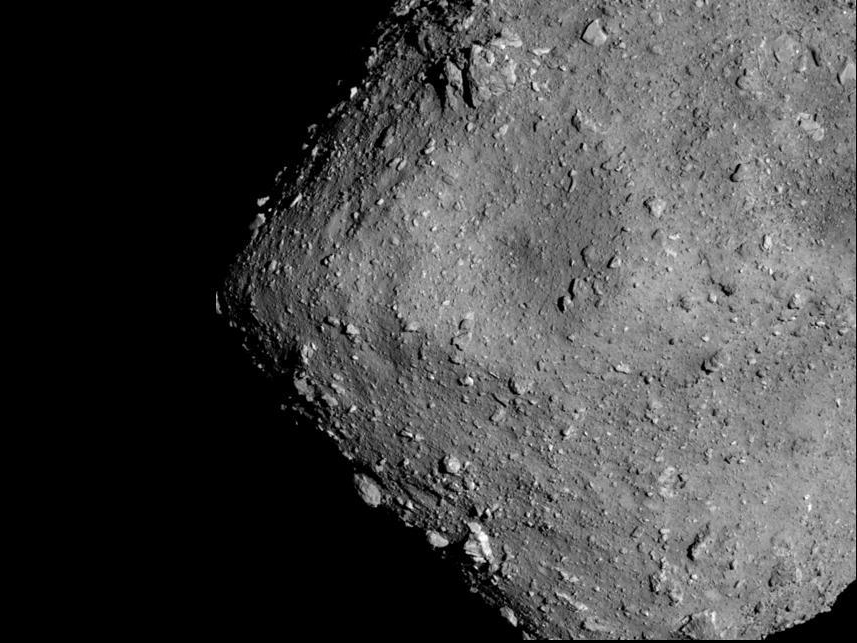

Asteroid Ryugu was somewhat of a mystery when astronomers first spotted it back in 1999. But we now know that the spinning-top-shaped body floating some 217 million miles from Earth is a loose assemblage of fragments from a collision between two asteroids held together by their aggregate gravity. Scientists estimate Ryugu formed between 10 million to 20 million years ago—practically yesterday in cosmic time, but how the asteroid came to be has remained largely unknown. Now, new research lays bare Ryugu’s recent violent past.
To uncover secrets about this rubble-pile asteroid, the Japan Aerospace Exploration Agency (JAXA) dispatched the fridge-sized spacecraft Hayabusa2 to Ryugu. For the study, published Monday in Nature Astronomy, scientists used images collected by Hayabusa-2 to parse the rock’s albedo—or reflective properties—to uncover clues to the asteroid’s cosmic mashup.
“We found hundreds of thousands of bright boulders on the surface, if you include the very small ones,” says Eri Tatsumi, planetary scientist at the University of La Laguna in Spain and lead author of the study. “When we started to look at the spectrum of them, we found that they are compositionally very different from Ryugu.”
Ryugu is a carbonaceous or C-type space rock, which implies it is essentially made out of rock that contains a ton of carbon and water. Though the vast majority of the asteroid is carbonaceous, researchers found material that’s water-poor and silicate-rich that likely belongs to an S-type asteroid. This leads Tatsumi and her team to believe Ryugu likely formed from the collision between a small S-type asteroid and a larger C-type parent asteroid. If the nature of this collision had been the other way around, they say, the ratio of C- to S-type material in Ryugu would be reversed.
The recent findings are “interesting,” says Paul Byrne, a planetary geologist at North Carolina State University who was not involved in the study. “For Ryugu to have pieces from other asteroids, those pieces couldn’t have “landed” gently without there having been far more of them, most of which would have had sufficient energy to break Ryugu apart entirely,” meaning those pieces should have been embedded into Ryugu before the asteroid as we know it formed.

Though this process is theoretically expected, Tatsumi points out this is one of the first times astronomers have spotted bits of an asteroid on the surface of another. She adds that new research suggests Bennu, currently orbited by NASA’s OSIRIS-REx, is also a rubble pile asteroid with chunks of Vesta (the asteroid visited by NASA’s Dawn spacecraft) on and inside it.
“Maybe this is a common process,” Tatsumi says. “We have Bennu and Ryugu and we can compare directly to each other through collaborations.”
“For such similar observations to be made for two different asteroids really does tell us that the formation of these bodies must have been incredibly violent, and something to behold,” says Byrne. “I can’t wait for us to get samples from both Ryugu and Bennu back to Earth, to learn more about these tiny worlds!”
Fortunately, we don’t have to wait long for more data on Ryugu: During its extended 16-month visit around the asteroid, Hayabusa2 dropped three rovers onto the asteroid and scooped some samples from the space rock’s surface. Having departed from Ryugu in November 2019, Hayabusa2 is expected to fly past Earth in late 2020 and release its samples in a reentry capsule for detailed analyses in labs across the world.
